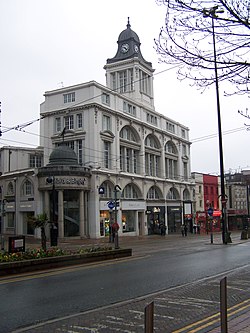Crazy Daisy Nightclub
53°22′58″N 1°28′04″W / 53.382823°N 1.467849°W
 The site of The Crazy Daisy Nightclub Today ('Blacks' is where the main entrance once stood) | |
 | |
| Former names | The Bier Keller, The Geisha Bar, Legends |
|---|---|
| Location | 20 - 21 High Street, Sheffield, S1 1PU, England. |
| Owner | Tetley |
| Type | nightclub |
| Genre(s) | New Wave |
| Construction | |
| Built | 1920s |
| Opened | 1979 |
| Closed | 1988 |
The Crazy Daisy Nightclub was a discotheque/dance club in Sheffield, South Yorkshire, England in the late 1970s to late 1980s. Located originally on the Corner of York Street and High Street, Sheffield S1 1PU. It was known as The Beer Keller in the early to mid 1970s. In 1978 it was taken over by the Tetley company and became The Crazy Daisy. Situated in the basement of an art deco building it featured numerous supporting pillars and a steep, sweeping staircase down from the entrance which was infamous for being responsible for many alcohol related trip accidents.
The Crazy Daisy club was in business from 1976 to the late 1980s. At the time it became synonymous with the avant-garde early 1980s music scene. During its tenure it was a central social focal point in Sheffield city centre and claims a key role in 1980s Sheffield culture and British pop music history. It later became The Geisha Bar (in the 1980s) Legends Nightclub and subsequently closed in the mid 1990s when the Sheffield social scene shifted to the redeveloped West Street area. The building is now used as a bank and shops, next to a Sheffield Supertram stop.
The Human League story
The club is principally known in UK/US pop history and worldwide as the 'birth place' of the 'Mark Two' (commercially successful) version of the pop group The Human League.
Where, in October 1980 during a visit to the Crazy Daisy. Almost as an allegory of the Cinderella story, Philip Oakey (lead singer of the group), randomly spotted and recruited two totally unknown school girls, Joanne Catherall and Susan Ann Sulley, into the group after the original members had walked out on the eve of an international tour. With no auditions or rehearsals, Sulley and Catherall were taken out of school to go on the tour with just 4 days' notice. The new group line up then rose rapidly to international prominence and enormous commercial success in the early and mid 1980s making internationally famous popstars of both girls.
The Human League continues recording and touring internationally to this day, 30 years later, still complete with Sulley and Catherall now in their mid-forties.[1]
Other famous connections
Another regular patron of the Crazy Daisy in the early 1980s was stage and Hollywood film actor Sean Bean who recalls his nights in the club during an interview for Exposed magazine in January 2007.[2]
The building today
The last nightclub to occupy the building was Legends, this closed in the mid-1990s and because the night time social scene had since moved on, the site was redeveloped into commercial units. Since its redevelopment an outlet of Blacks outdoor pursuits store is now where the main entrance once stood and the bank Santander dominates the main building. Today there is no indication of the building's heritage or history. Because of its history the site is mentioned on a number of Sheffield tour guides, Sheffield city web sites and almost every Human League website/book.[3]
In the media
- In 2004 for its association with The Human League, The Crazy Daisy was nominated as one of Britain’s top ‘Rock Landmarks’ in a feature program of the same name, although it did not eventually make the final top 10.[4]
- In 2007 the VH1 UK documentary The Nation's Music Cities – (Sheffield) (first broadcast on 26 May 2007) featured a prominent section on The Crazy Daisy. The documentary included an interview with Susan Ann Sulley and Joanne Catherall which was filmed outside Blacks (the former club entrance), where they discussed the building’s significance and its history in the 1980s.[5]
- In 2008, artist Pete McKee produced a Pop Art painting entitled "The Night Phil Oakey met Susan and Joanne" which depicts Sulley and Catherall arriving at The Crazy Daisy on the night they were discovered in October 1980.[6]
References
- ^ A Band Called The Human League by Alaska Ross ISBN 978-0-86276-103-5
- ^ Interview Sean Bean, Exposed Magazine January 2007
- ^ HUMAN LEAGUE BIOG 1977 - 1979
- ^ BBC NEWS | Entertainment | Rock history landmarks celebrated
- ^ VH1 Documentary 'The Nations Music Cities' first broadcast in UK 26/05/07
- ^ The Sheffield Star 15 April 2008
